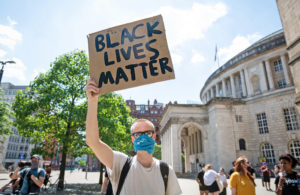What was I — a lifelong Democrat — doing at an election watch party in rural Virginia, surrounded by Republicans? As Ron DeSantis, 800 miles away, filled a huge TV screen with a post-landslide victory speech, he provided part of the answer: “We chose education over indoctrination!” He got a raucous round of applause from the crowd at the Marriott Ranch, in the foothills of the Blue Ridge Mountains. Even I joined in.
I have come to realise that party affiliation is far less important to me than fealty to the values that made it possible for me, a Muslim immigrant from India, to prosper in America. In the summer of 1969, I arrived at JFK International Airport as a four-year-old with no English, destined for a new home in New Jersey and then Morgantown, West Virginia. My parents had made a keen study of US history. They knew it was a nation that had its flaws, but they were encouraged by some pivotal developments, particularly the landmark 1954 Brown v. Board of Education decision, which banned racial segregation in public schools and declared unequivocally that race cannot play a role in school admissions. This, they thought, was a fair place to raise their kids.
When I came to learn my adopted nation’s history myself, at Martin Luther King Elementary School, I understood that the painful legacy of slavery was part of it. But I also knew that good and thoughtful people in the present had made honest attempts to address these issues — by passing laws banning racial discrimination, for instance. I hardly thought the US perfect but, as a native of India, I understood that societies that dwell forever on historical grievances tend not to be happy, free or prosperous places. America was fundamentally — and wonderfully — different.
But, in recent years, something very disturbing has happened. That is why, on the night of the midterm elections, I drove west after sundown on Route 66 with my friend Harry Jackson, the first black PTSA president at my son’s alma mater. We were driving to a party of kindred spirits, most of whom didn’t look anything like us.
Why? Because the Democratic Party, which once valued fairness and justice, has, alas, been torching the American Dream. Democratic politicians, school boards, governors and even US Supreme Court justices are pushing “equity” over equality, “anti-racist” bigotry over colour-blindness, and mediocrity over merit. Literacy and maths scores are plummeting nationwide, while black and Hispanic kids are falling further and further behind — and yet progressive Democrats are far more interested in bringing crackpot racialist theories into our classrooms. In other words: they choose indoctrination over education.
As a teenager and young American, I trended liberal. In the Eighties, I opposed former Republican President Ronald Reagan’s military escapades into Central America, his demand that young men register for the draft and his efforts to ban abortion. Decades later, I moved to Virginia as a single mother with a six-year-old son. Though the state’s history was steeped in racism, Virginia had just voted for a black man to be president. I thought it had finally become progressive enough for a woman of colour like me to raise a child freely.
But among the loudest voices ahead of last week’s midterm elections were those of aggrieved parents, who are waking up to the fact that Democrats aren’t defending a fundamental American value: that children should not be judged on the colour of their skin. Affirmative action wasn’t explicitly on the ballot, but the question of whether we are merit-based and colour-blind was the subtext of multiple campaigns.
In Union City, in the San Francisco Bay, Jeff Wang, who immigrated to the US from China in 1984 as a student, won with the campaign mission that his “American Dream” is to help others “achieve their ‘dream’”. In southern California, Republican Michelle Steel, an immigrant from South Korea, faced a tough race in the 45th Congressional District against her Democratic opponent (who is Taiwanese American). Earlier this year, Steel signed an amicus brief with 81 congressional colleagues against the use of race in college admissions. “Shutting the door to applicants based on race is wrong,” she later wrote. There was not a single Democrat among the signatories. With votes still being counted, Steel is the frontrunner in her race.
I was 13 when the US Supreme Court Justice ruled, in a landmark 1978 case (Regents of the University of California v. Bakke), that universities could take race into account in admissions if there was a “compelling interest” — like needing to remedy past discrimination — but otherwise it banned racial quotas. In theory it makes sense to correct still-raw injustices with so-called affirmative action. But on the ground, we can’t realise “diversity” just by filling race-based quotas. My father ticked so many “diversity” boxes, but as a teen I saw him devastated by a decision: he had found a home at West Virginia University, happily teaching clinical nutrition, but (white) administrators in the late Seventies denied him tenure. I learned what it meant to fight the machine: my father appealed, represented himself and won tenure, not through quotas, but grit.
The watch party was full of people with equally impressive trajectories. The host was Republican congressional candidate Hung Cao, who arrived in the US as a refugee from Vietnam after the fall of Saigon in April 1975. His family settled in low-income housing in Reston, Virginia; in 1985 Cao entered the first class of a new selective school, Thomas Jefferson High School for Science and Technology. It had been established to make the US competitive against the Soviet Union in the new field of “STEM”. Back then, local Fairfax County was mostly white, and so was the school, but with increases in the number of Asian technology workers, more of their children started acing the school’s merit-based admissions tests.
Meritocracy, is seemed, was winning. Over the next years, nine states banned public colleges and universities from considering race or ethnicity at all in admissions to public institutions, kicking off with Proposition 209 in California in 1996. But in the summer of 2003, with my son just a newborn, the US Supreme Court ruled 5-4 in Grutter v. Bollinger that universities may use “narrowly-tailored”, “race-conscious” admissions as a “plus” in their efforts to achieve “diversity” on campus — as long as diversity isn’t defined “solely” by race and ethnicity. Former justice Sandra Day O’Connor wrote the majority opinion with a sentence that would haunt the court years later. She wrote: “The Court expects that 25 years from now, the use of racial preferences will no longer be necessary to further the interest approved today.”
The goal of diversity is noble in spirit. But the philosophy of “critical race theory” that dominates so many admissions departments today is toxic and illiberal. The focus is on increasing admissions of black and Hispanic students, meaning that hard-working Asian American students become sacrificial lambs in their racial experiment, caught in the crosshairs of preferential treatment for other minorities, as part of a war on merit. Indeed, one of America’s best-known “anti-racists”, Ibram X. Kendi, writes: “The only remedy to past discrimination is present discrimination.”
In an attempt to stop racism in the name of “diversity”, more states banned race as a factor in hiring or admissions, including Michigan in 2006 and Oklahoma in 2012. In 2013, the US Supreme Court ruled in Fisher v. University of Texas at Austin that race can be considered in admissions only under “strict scrutiny”. Late the following year, in 2014, a new organisation, Students for Fair Admissions, filed lawsuits on behalf of Asian American students in federal court against Harvard and the University of North Carolina at Chapel Hill — for, among other things, violations of Title VI of the 1964 US Civil Rights Act, which prohibits any schools that receive federal funding from discriminating against people based on race and other identity markers. The Supreme Court’s ruling is expected to land next spring.
But then came the “racial reckoning” of 2020. In the spring of that year, Harry Jackson’s son was one of six black students admitted to Hung Cao’s alma mater, Thomas Jefferson High School for Science and Technology. By then, my son was a sophomore at the school, admitted through its race-blind, merit-based admissions process. Little did we know that the school was about to be targeted by “equity warriors”, spurred on by the killing of George Floyd. Our school’s population was 70% Asian — but we were the wrong kind of brown for activists.
That autumn, as my son became a junior and Jackson’s son became a freshman, the local 12-0 Democratic school board became obsessed with rigging the admissions process so that the low number of black and Hispanic students would increase dramatically. In December 2020, in a devastating decision for kids who had been working hard for months to hone their maths skills, the board replaced the school’s merit-based admissions test with a new racially-engineered system that assigned “bonus points” to factors that were seemed like a proxy for race. One of the board members, Abrar Omeish, actually acknowledged in a text message to another member that the new process had an “anti-Asian feel…hate to say it lol”.
In the spring of 2021, a group of our families sued the school board for violating the 14th Amendment, in Coalition for TJ v. Fairfax County School Board. While Democrats condemned us, the Virginia gubernatorial candidate, Republican Glenn Youngkin, understood us. He sent us a video, supporting our efforts to maintain merit-based admissions. At almost 11pm, in his final rally of the election last year, off the backroads of Loudoun County, Virginia, Youngkin declared: “We will not be a Commonwealth of dream stealers. We will be a Commonwealth of dream enablers and builders.” The crowd, including myself, cheered.
And our vision of the American Dream triumphed. In March 2022, a federal judge ruled that the new admissions’ system was “patently unconstitutional”, because it discriminated against Asian American students. In the parlance of “anti-racists”, school officials had put in place systemic racism. The next month, Cao stood with other Asian American families — including my father, then 87, and me — at the steps of the US Supreme Court to argue against racism towards students of Asian descent in admissions to his alma mater. Soon after, Cao, a political newcomer, beat out a tough field of (all white) Republicans to run against Jennifer Wexton, the (white) Democratic incumbent for the 10th Congressional District of Virginia. And it wasn’t long ago that I was back on those steps. On Halloween, I walked into the US Supreme Court, as lawyers from both sides made their arguments in the case against Harvard and the UNC Chapel Hill.
It was hard to watch the so-called liberal justices turn a blind eye to the blatant anti-Asian racism that has become a hallmark of admissions to schools. But I felt great hope as the majority conservative justices expressed outrage over the “race conscious” biases in admissions. My prediction — and that of legal experts — is that the Court will bar Harvard and UNC Chapel Hill from using race in admissions, ending “race-conscious” systems that discriminate against Asian American students. Schools will likely get sneaky about how they use race, but, in a short video filmed outside the Court, I declared that the day was a “win for America” and all children.
That video, once posted, triggered an assault like I had never witnessed before. Pamela Denise Long, a contributor to Newsweek and the creator of “trauma-informed” “humane antiracism” training, shared an image of me from the video and admonished me for “coming to somebody else’s country” and using “their laws” to win rights. I was disparaged as a “tool of white supremacy”, promoting a “wannabe white supremacist ideology”.
My views fall well within the mainstream of the vast majority of ordinary Americans: a new Pew poll of American adults found 74% think race or ethnicity “shouldn’t be considered” in admissions. Moreover, they are supported by countless black leaders. On the eve of Halloween, as Cao waged his battle for political office, Harry Jackson joined a rally of about 500 Asian Americans supporting the lawsuits against Harvard and the UNC Chapel Hill. “I am an ally!” he said. Next to him, an Asian American boy carried a sign: “I have an American Dream too.”
Any yet, my views get me pilloried. Self-described anti-racists bombard me with the view that I am “white adjacent”, “honorary white”, “white passing”, and part of the “dominant culture”. These attacks are reminiscent of the words of white extremists. And yet they come from a movement called “Foundational Black Americans” — which espouses the “Great Replacement” theory of white supremacists, accusing immigrants, including black immigrants from the Caribbean and Africa, of stealing resources. In one radio show, founder Tariq Nasheed accuses black immigrants of being “tethers” to America with “anchor babies”, “smelling like booty juice and flies”, “smelling like cheetah pee” and taking jobs and resources owed to black people born in the US. Nasheed says Foundational Black Americans is not a hate group, but rather a “lineage”.
My suspicion that the ire directed at me was a comment on my immigrant status was confirmed on the drive to the watch party. Speeding along the tarmac of Route 66, I got a message: “Go back to India.”
By the time I got there, I’d been accused of coming from an “upper caste family” (though I am Muslim, not Hindu); of being a “white Aryan Indian”, allegedly descending from the Aryan tribe that captured Hitler’s imagination; and of having “musty underarms”. “You Asians are the pets of white supremacy, flat face,” wrote one Twitter user.
It is worth saying again: among all this, it is the Republicans, not the Democrats, who are standing up for us. At the party, I was surrounded by people, like me, who feel they have been mugged by the political party that once shared our values and goals — but now gives us no choice but to reach out to the other side. Ron DeSantis and Glenn Youngkin understand our concerns. Joe Biden and the progressive ideologues in his party wish we would go away — and belittle us when we refuse. And refuse we do.
At 10pm, the results were in. In a near-final tally, Wexton won 52.83% of the votes while Cao won 46.98%, narrowing the win to six percentage points, compared to Wexton’s 13 percentage point win in her last election in 2020.
“It hurts,” Cao acknowledged to the crowd, but he also stressed that he would never want “race-conscious” allowances to push him, as a minority, to victory. That is the way it should be, whether in schools or society at large. And he will continue fighting for that version of the American Dream. Like me, he declines to live in a society in which people who ought to know better judge, shame and browbeat us because we embrace honesty, hard work and education. We are not the racists here. We are the American Dream.
Disclaimer
Some of the posts we share are controversial and we do not necessarily agree with them in the whole extend. Sometimes we agree with the content or part of it but we do not agree with the narration or language. Nevertheless we find them somehow interesting, valuable and/or informative or we share them, because we strongly believe in freedom of speech, free press and journalism. We strongly encourage you to have a critical approach to all the content, do your own research and analysis to build your own opinion.
We would be glad to have your feedback.
Source: UnHerd Read the original article here: https://unherd.com/





